It’s not news to anyone that there is a labor shortage in a variety of service, transportation, manufacturing, healthcare services, and hospitality sectors, among others. The common refrain as the pandemic wound down and life started to get back to normal was that the missing workers would return. Clearly that hasn’t happened. Economists’ estimates are that as of the start of this year, there are 2.9 million people missing from the nation’s workforce. That’s roughly how many more Americans should be working or looking for jobs if the economy’s labor force participation rate was the same as before the covid pandemic.
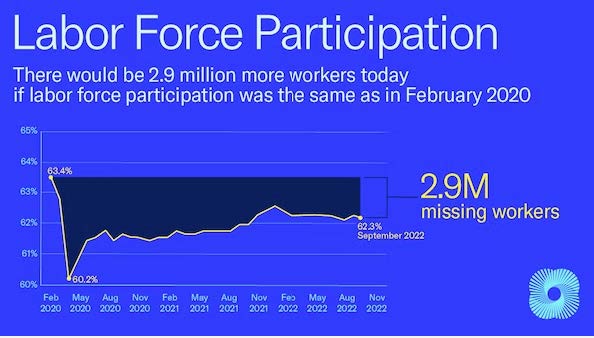
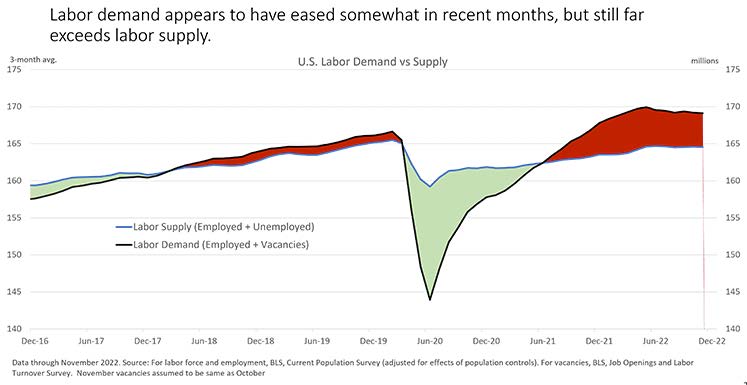
What Researchers are Finding
Much is being written of late to figure out what is happening. Here are some factors that have been put out there for discussion:
- Aging population
- Rise in Mortality Rates
- The “Great Resignation” and Shrinking Low Wage Workforce
- New Business Starts
- Increased Savings Rates
Aging Population
The chart below tells us all we need to know about the changing demographics of the labor workforce. The number of people aged 25 to 54, a group economists call “prime-age” workers, inched up just 40,000 in 2022. Meanwhile, the number of Americans 65 and older jumped by 2 million. That continues a pattern. Since 2019, the prime-age worker population has barely changed while the size of the 65-and-older group has increased by nearly 5 million. These differences affect labor force growth because the prime-age population is far more likely than seniors to be in the workforce.
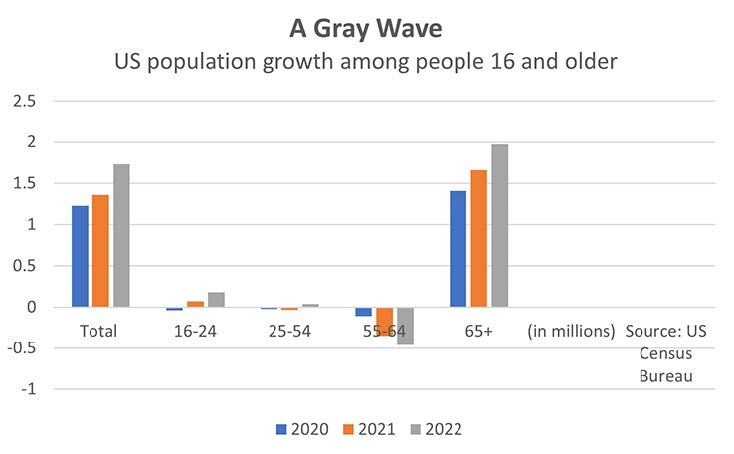
Sharp Rises in Overall Mortality Rates
The chart below from the US Census Bureau gives a clear picture of the increase in mortality rates across the entire population as covid started to spread. Note that death rates from flu viruses broadly speaking are seasonal and increase during coller winter months versus more mild summer months.
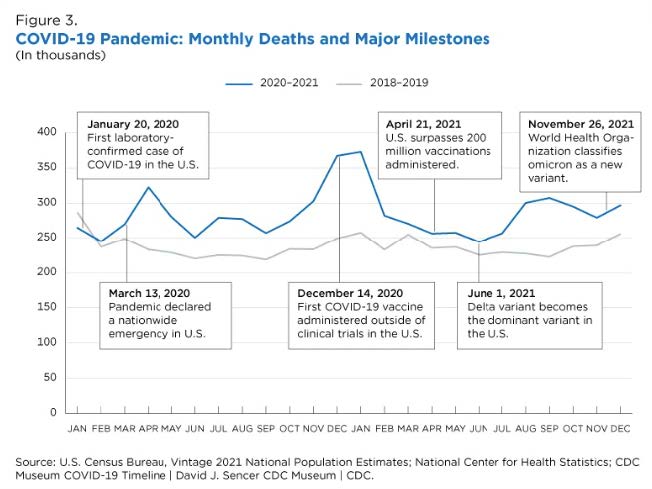
Another interesting way to think about the rise in deaths over the past two plus years is to look at group life insurance payout trends. The chart below shows you the 20% jump in benefit payments in 2021 over the 15-year average. Group life insurance provided by employers covers a larger population of millennials including young and middle-aged people than the elderly.
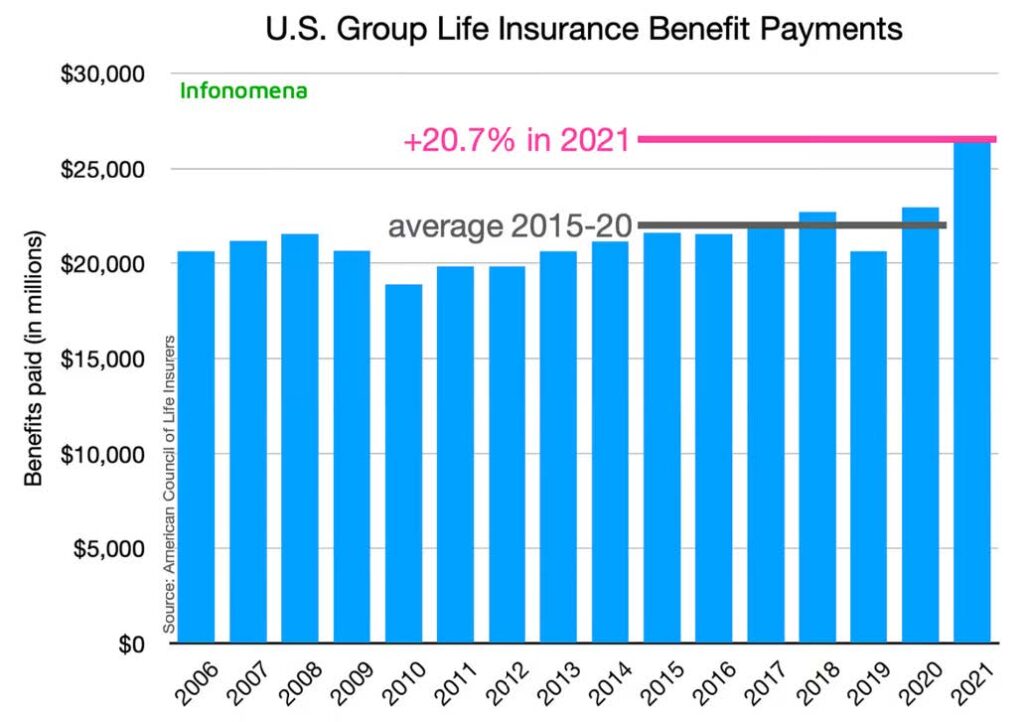
There is a lot to unpack in this data and while covid certainly had an impact in the rise in mortality, it was clearly not the only reason. There are many potential reasons for the rise in “all-cause” deaths beginning in 2020 and continuing today. The most interesting conclusion from the data gathered by researchers is that the millennial generation saw greater increases in
mortality than the older population over the past two years which cuts right into the available workforce.
The Great Resignation
Shifting away from the millennial working population, researchers have put together data on resignation trends over the past 2 years. The two illustrations below from the US Chamber of Commerce and Bureau of Labor Statistics paint a clear picture of what has transpired over that timeframe.
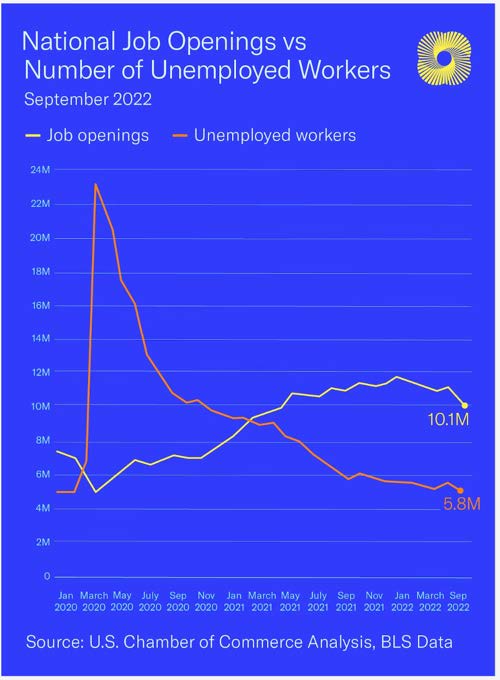
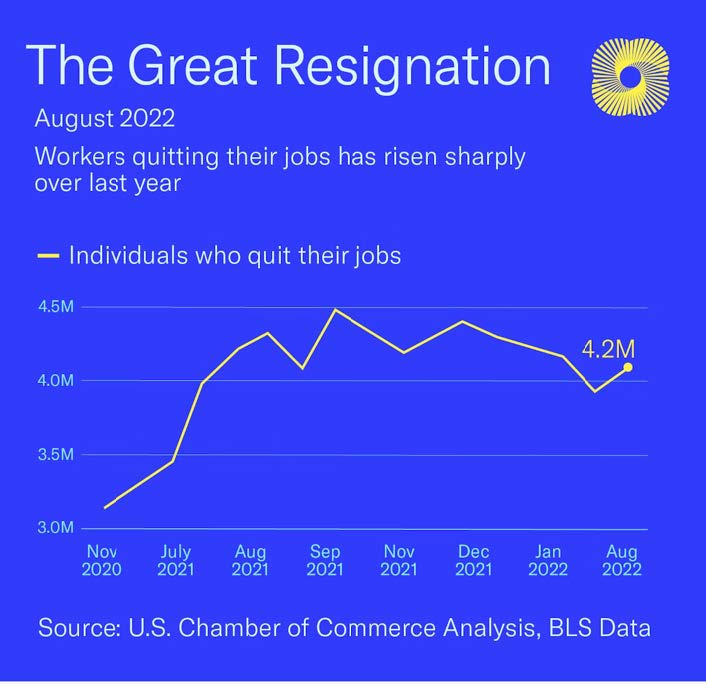
Estimates are that over 50 million people quit their jobs in 2022. To be sure, many of them who quit cited higher pay and better working conditions as incentives. More importantly, the sharp decline in the low wage workforce (Avg. Wage <$29,000/year) has had an outsized negative impact on sectors such as food service, hospitality, healthcare services, retail trade, delivery services, etc. Reasons commonly cited relate to mistreatment by employers and customers. Especially hard hit are the higher cost regions where low wage workers are simply leaving because many of their employers in such service categories shut their doors for good as the pandemic unfolded. Lack of compliance with covid vaccination requirements is also a contributing factor.
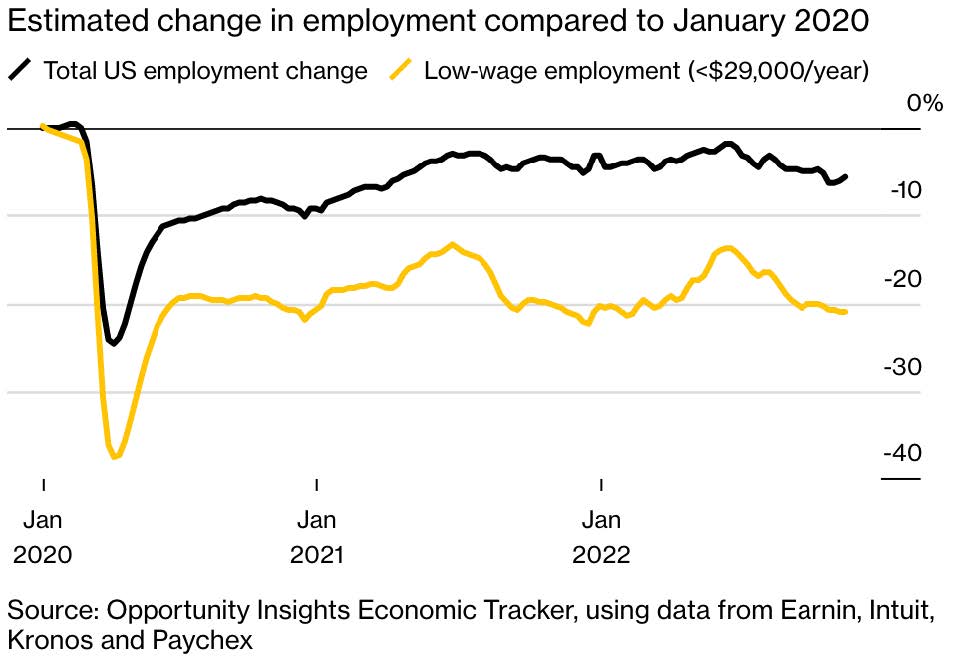
Below is a chart highlighting industry quit rates, rates that only include voluntary separations. Overall quit rates broadly speaking have hovered between 1.5 – 2.0% over the past 25 years.
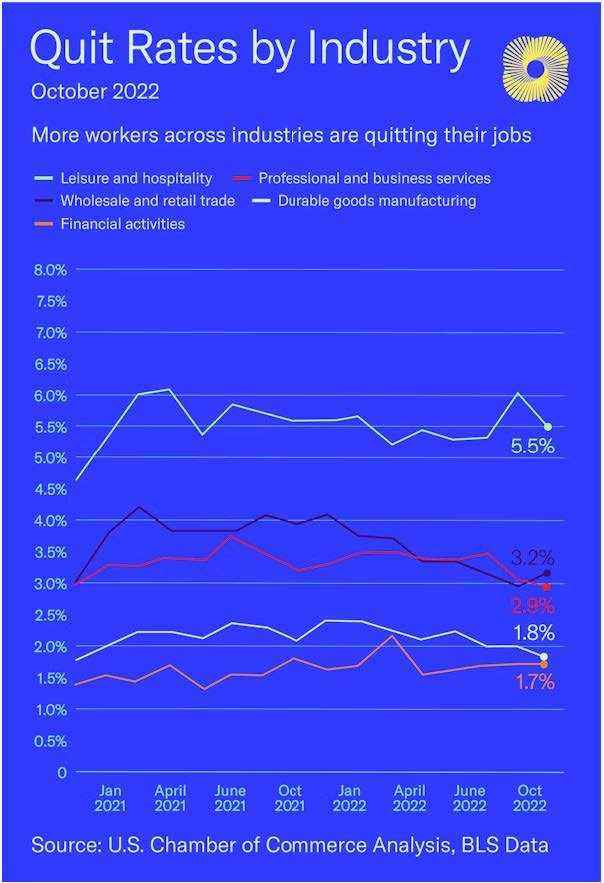
Additional Contributing Factors
- Lack of Childcare – Nearly all childcare workers are women and as daycare centers closed, available services rapidly declined. Estimates are that by the Spring of 2020, 3.5 million mothers left the workforce leading to a decline in participation rates from 70% to 55%. Things are improving but have not fully recovered.
- New Business Starts – Over the past two years, nearly 10 million new business applications were filed and in 2020 alone more than four million new businesses were started. The entrepreneurial spirit hit a lot of workers which has contributed to the lack of workers for existing jobs.
- Higher Savings Rate – With all the financial assistance that the government doled out, some feel that workers can stay out of the labor market longer than one might think. This is temporary but may still be having some lingering impact.
Aviation Industry – A Closer Look
Pilot Shortage
I will keep it to a North American discussion with the understanding that pilot shortages are being felt worldwide. The chart below from management consulting group Oliver Wyman, gives us a clear picture of what the future holds.
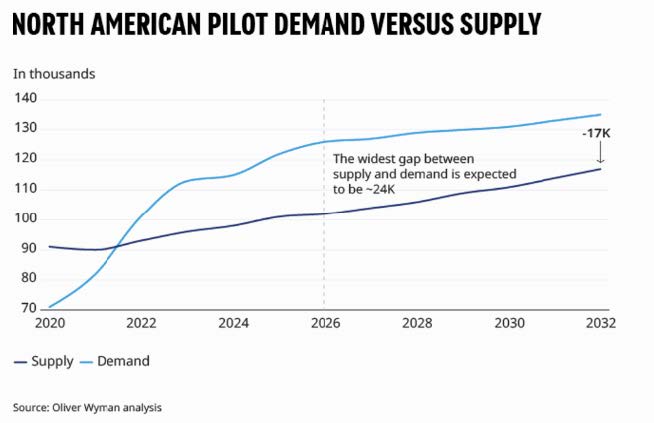
Much has been written about the current and ensuing pilot shortage situation. I will try to keep this brief as I realize that many clients of Mountain Capital are in the aviation industry and are quite familiar with the situation.
Common Reasons Cited as Causes for the Pilot Shortage:
- Baby Boomer pilots reaching mandatory retirement age
- Early retirements during the pandemic
- Fewer potential recruits from the military as conflicts are scaled down and the use drone technology increases
- High training costs
Potential Solutions
- Raise the mandatory retirement age to 67
- Lower the 1,500 flight-hour requirement
- Airline financial assistance/sponsorships supporting various training stages
- Bring more women and minorities into the hiring pool
There is a lot to consider regarding the potential solutions above and again, I realize that many clients of Mountain Capital are more well-versed about them as I am. I will note one issue in that it seems raising the retirement age is not the panacea one might expect. The apparent reality is that airline pilots close to retirement age generally work fewer hours, take more time off than their younger counterparts, and spend more time training other pilots. This means that a senior pilot retiring two years later is not necessarily equivalent to an extra two years of flying that a moderately experienced pilot would do. In general, it will take years to feel the positive effects of attempts to increase the number of pilots projected to be needed over the next 10 years or more.
Aviation Mechanic Shortage
In addition to the pilot shortage, researchers also note the growing lack of airline mechanics. The Oliver Wyman folks put together the chart below with their estimates of current and future supply and demand projections over the next 10 years. They suggest that this gap between supply and demand could lead to fewer flights, and delays and cancellations or airlines having to compensate by keeping more spare aircraft and parts on hand. That cuts into airline profit margins which as we all know airline operators want to avoid.
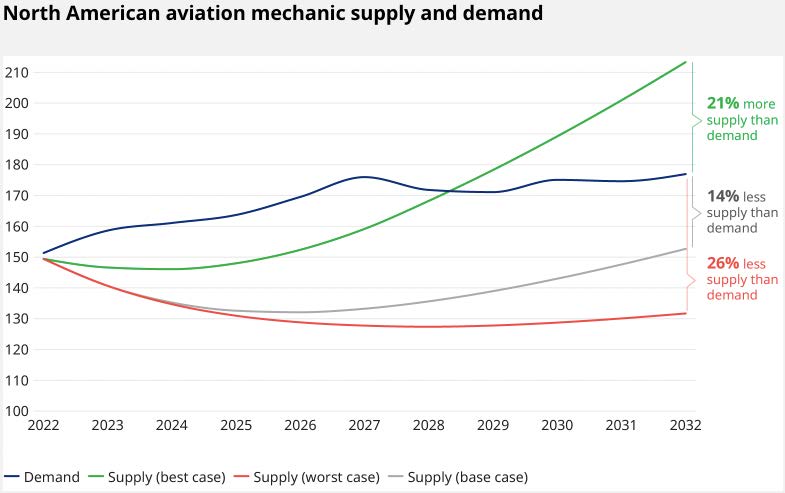
Wrapping Up
Labor shortages across the economy are real and not going away anytime soon. The January jobs number came out last week with a shocking 517,000 new jobs added versus estimates of only 185,000. The unemployment rate declined to 3.4%, the lowest in over 50 years.
Unfortunately, solid new job growth indicates signs of a strong economy which is not what the Federal Reserve nor the stock market wants to see right now. All that indicates is that we have more rate hikes coming. We are in a “good news is bad news” situation which will continue until we see labor demand subside as well as upward pressure in hourly wage growth, a core component of rising inflation. My view is that we are getting close to seeing the Federal Reserve relax a little on future rate hikes but with the jobs report from last week, it is not as close as I had hoped. The mystery remains “Where did all the workers go?” and “When will they come back, if ever?”
